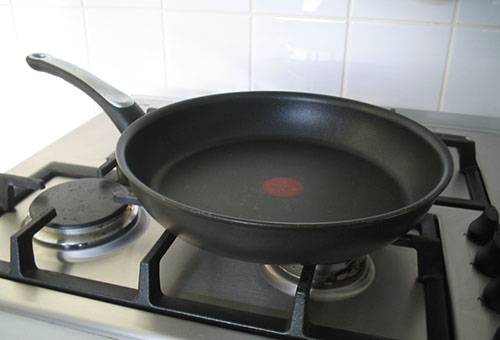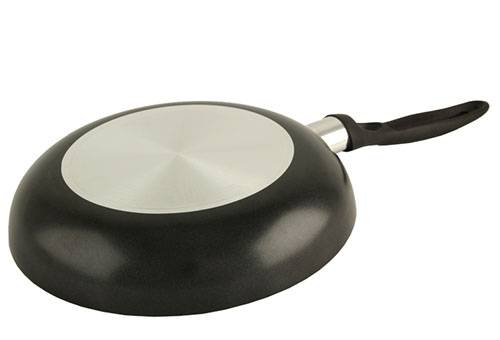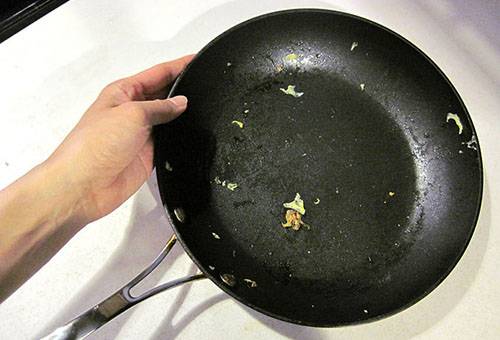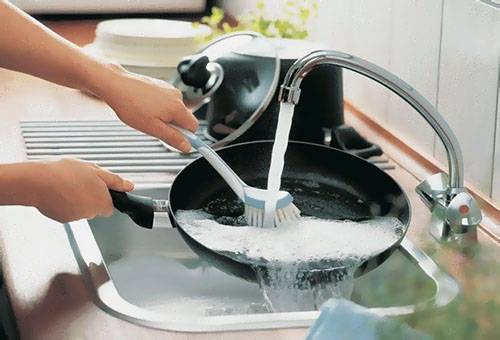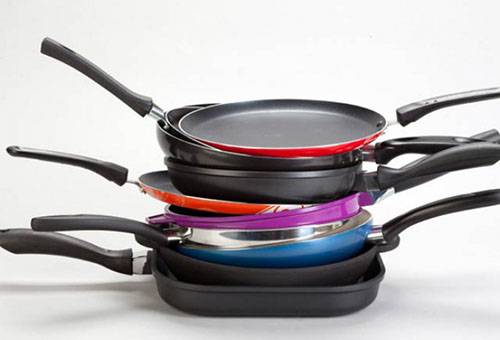How to easily clean a non-stick pan?
Content:
The formation of soot on dishes cannot be avoided even by the most clean housewives, because fat tends to accumulate on the walls of dishes. At the initial stage, fat is difficult to see on the surface of the dishes. But over time, its amount increases, and getting rid of it is quite difficult, but possible.
Teflon Pans
Today a Teflon pan can be found in almost every home, because this dishware is practical and convenient to use, cooking becomes easier and more enjoyable, because it does not stick and does not stick to the surface. But besides this advantage, there is also a huge minus, namely, that it is difficult to clean a non-stick pan. This is due to the fact that a fragile coating requires special care, which is why for cooking in such dishes, the use of wooden or silicone blades, spoons and tongs that will not damage the surface, unlike metal ones, is provided.
Carbon deposits on dishes may result from improper use, so before you start using the pan, you should study the instructions for it in detail or ask the seller what are the main requirements for caring for it. This will eliminate future questions about how to clean a non-stick pan.
How to clean a non-stick pan outside?
To clean a non-stick pan from the outside is easier than inside, since the outside does not come in contact with food. Thus, care for it can be entrusted with chemicals that are provided for the fight against burnt fat.
Use the following methods to clean the teflon pan from the outside.
- Creamy and gel-like substances (Domestos, Antinagar), which, when applied to the surface, corrode stale fat, which can then be easily removed with a dishwashing sponge.
- Means for cleaning fat ("Mr. Muscle"), which are sprayed onto the outer surface of the dishes and within a few minutes break down the fat, which is then easily washed off with a sponge.
- To clean the dishes from soot can be using liquid products ("Milam"), which, half an hour after application, show tremendous results in the destruction of fat.
Cleaning carbon deposits on the inside
At first glance, getting rid of carbon deposits inside dishes with a non-stick coating is easier than with an external one, because it can be cleaned frequently after cooking. But with a Teflon coating you need to be extremely careful. It is contraindicated to use powdered detergents that contain abrasive particles that destructively affect the coating as auxiliary agents for caring for this type of tableware.
The best ways to deal with burnt fat are the following methods.
- A frying pan filled with water is placed on low heat and brought to a boil. Then a small amount of liquid detergent is added and removed from the fire. It cools down for an hour and washed with plenty of water with a sponge.
- Using a dishwasher that eliminates a small accumulation of fat on its own. But do not expect that the result will appear after the first wash.
Do not use chemicals or hard sponges on the inside of the pan, which can damage the coating and shorten the life of the dishes.
Universal Ways
If there is a need to simultaneously wash a non-stick pan on both sides, it is recommended to use the following methods.
- In a capacious container, such as a bowl or boil, bring to a boil three liters of water. After the water boils, place 150 grams of liquid detergent, 50 grams of silicate glue and 200 grams of soda in it. Stir thoroughly and place in our mass our non-stick cookware for two hours. After the specified time, remove the dishes and get rid of soot with a sponge and water.
Tip
If a lot of burnt fat has formed, then the time spent by the dishes in such a solution increases.
- You can also clean the pan with such a coating using another solution: 3 liters of water, 100 grams of silicate glue, 1 bar of laundry soap, ground on a grater. The procedure is similar to the previous one, and in order to wash the dishes from soot, it must be placed in this solution and boiled over low heat for two hours.
How to prevent carbon deposits?
Any problem can be prevented, the occurrence of soot on dishes with non-stick coating is no exception. Naturally, you can give the dishes a second life and clean the pan soiled beyond recognition, but it is better to avoid this situation and not rack your brains, looking for ways to solve it.
In order for dishes with non-stick coating to always be in perfect condition, you must follow simple rules.
- Clean it after cooking. Let this process take a little time, but in this way you will be able to avoid hours of work to eliminate your own mistakes.
- It is not recommended to heat the dishes to temperatures above 250 degrees. At this temperature, the integrity of the coating is destroyed, it is deformed, which contributes to a decrease in non-stick characteristics, moreover, it will be more difficult to wash the pan later on.
- To exclude the use of metal products for cooking that destroy the surface of dishes. The fat penetrates into the scratches, and it will be difficult to clean it in the future.
- Clean the pan outside. It is recommended to do this at least once a week. To remove a small amount of fat accumulated on the outer surface is much easier than to eliminate its accumulations that have formed over a long time.
Normally, soot should often not form on the inside of the pan. Its regular appearance may indicate that the integrity of the coating was impaired, and it is not recommended to use such utensils for cooking.
